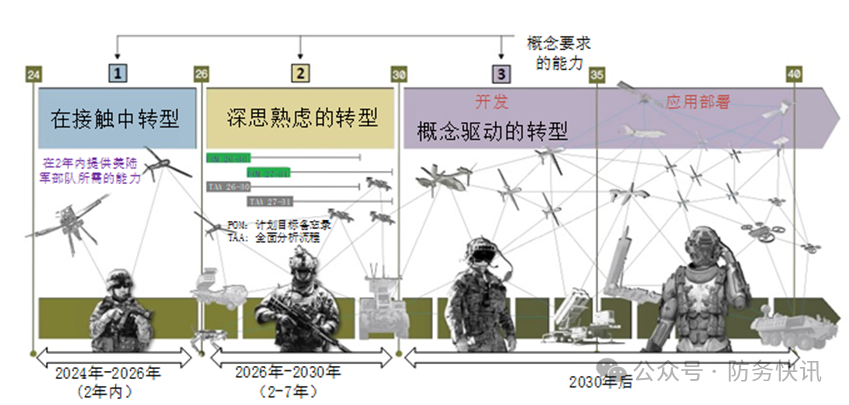Previous Review
[Command and Control] The Core of the U.S. Army’s Digital Transformation – Next Generation Command and Control (NGC2)
[Command and Control] The U.S. Navy Successfully Tests the Virtual Aegis System During the U.S.-Japan “Sword” Exercise
Introduction
In February 2024, General James Rainey, commander of the U.S. Army Futures Command, pointed out that the iterative updates of technology have had a disruptive impact on the U.S. Army’s equipment, operations, and command. To address these challenges, the U.S. Army has proposed a continuous transformation plan aimed at better adapting to the demands of future warfare through a series of strategic adjustments, technological innovations, and organizational changes, thereby maintaining its competitive edge in the global military arena.
1
Introduction
The U.S. Army’s continuous transformation plan consists of three phases: the “Transformation in Contact” phase, the “Deliberate Transformation” phase, and the “Concept-Driven Transformation” phase (see Figure 1). This article focuses on the first phase, the “Transformation in Contact” plan. This initiative is driven by General Randy George, the Chief of Staff of the U.S. Army, along with other senior leaders, covering multiple theaters including Europe, the Pacific, the Middle East, and the U.S. mainland. In addition to the U.S. Army’s command headquarters, various centers of excellence, project execution offices, cross-functional teams from the U.S. Army Futures Command, and other relevant agencies are also involved in this plan.

Figure 1: The Three Phases of the U.S. Army’s Continuous Transformation
2
Background of the Transformation
As the U.S. military shifts its focus from counter-terrorism operations to great power competition, the U.S. military and its allies are competing with near-peer adversaries. The rapid development and creative application of new technologies are changing the way military forces operate, organize, and equip themselves. This change necessitates that the Army must possess greater flexibility and adaptability in future operations to remain undefeated in complex and dynamic environments. Units that fail to master new technologies and adapt to new changes will face severe penalties in future combat.
However, according to the U.S. Army’s existing weapon procurement process, it takes at least two years from the concept of a new technology project to its application, during which it must undergo several steps including validation, approval, budgeting, and competitive procurement. By the time two years have passed, the Army’s needs may have already changed. With the “Transformation in Contact” concept, the U.S. Army can use special funds to directly procure mature commercial technologies and products while shortening training cycles. Gab Camarillo, the Deputy Under Secretary of the Army for Acquisition and Logistics, stated that previously, concentrated training was conducted only after new equipment was in place, whereas commercial products are easy to operate and not classified, allowing soldiers to use them directly or explore them on their own, thus reducing overall training time.
3
Main Work
The U.S. Army aims to provide special funding through the “Transformation in Contact” plan to rapidly procure the latest commercial off-the-shelf technologies and products for brigade and below units, conducting real-world testing through unit rotations or the formation of new task forces based on specific missions. The test results will be fed back to the senior leadership of the U.S. Army, which will decide whether to promote the relevant technologies and products. This approach changes the traditional top-down design model of equipment in the U.S. Army, achieving a bottom-up push for transformation. Through a series of specific measures such as technological innovation, organizational change, and shifts in operational concepts, the U.S. Army aims to enhance its command and control, network communications, situational awareness, and fire support capabilities, enabling it to quickly adapt to the complex operational environments of the future. The U.S. Army plans to complete the “Transformation in Contact” phase within two years.
(1) Strengthening Command and Control Capabilities
The senior leadership of the U.S. Army has designated the modernization of the mission command network as the top priority of the Army’s continuous transformation efforts, seeking a simpler, more intuitive, low-signature, and rapidly iteratable mission command system. The U.S. Army is advancing the modernization of its mission command network through two programs: “C2 Fix” and “Next Generation Command and Control” (NGC2).
The “C2 Fix” program primarily addresses the current issues faced by the U.S. Army’s mission command network, which is too complex and lacks interoperability. It aims to integrate and simplify the existing network infrastructure, enabling commanders to utilize the mission command network more efficiently and conveniently. This program particularly focuses on the effective integration of various operational functions such as command, intelligence, firepower, and logistics. During the “Operation Lethal Eagle 25.1” exercise held in February 2025, the U.S. Army tested the new command and control architecture of C2 Fix. During the exercise, the 3rd Brigade split its command post into a main command node, tactical command node, and support command post, achieving a highly decentralized battlefield deployment and significantly reducing electromagnetic signal signatures. The tactical command node utilized next-generation tactical vehicles (NGTV) equipped with silent engines, capable of setting up and relocating communication equipment within 15 minutes, avoiding detection by enemy electronic reconnaissance.
The “Next Generation Command and Control” program is a new command and control system being developed by the U.S. Army to meet the demands of future great power competition and joint all-domain operations. It aims to establish a data-centric command system, reconstructing the Army’s enterprise data architecture and operational software framework. Through a simple and intuitive software approach, commanders can obtain a unified operational picture that meets combat needs. On May 28, 2024, General Randy George signed the capability characteristic requirements document for the “Next Generation Command and Control,” providing guidance for advancing the modernization of the U.S. Army’s mission command network.
In the 2024 “Convergence Project – Keystone 4” test, some features of the “Next Generation Command and Control” were preliminarily tested. For example, the test team used a commercial technology called “Raspberry Pi” to establish a command post in minutes, whereas it previously took several hours. They also quickly simulated the electromagnetic signatures of 16 command posts using “Raspberry Pi” technology as decoys, thereby protecting the command posts from interference and other cyber attacks. This novel approach not only improved efficiency but also enhanced the command post’s resilience against interference. This flexibility and adaptability reflect the “Next Generation Command and Control”‘s suitability for future battlefields and is a goal pursued by the U.S. Army’s “Transformation in Contact” initiative.
In the “Convergence Project – Keystone 5” exercise held in March 2025, the U.S. Army expanded NGC2 to a complete armored battalion and placed it within a brigade command post, conducting capability tests for the first time in scenarios close to real combat conditions. This experiment not only tested the system’s functional integrity but also provided first-hand data on system performance. This data is crucial for subsequent improvements as it directly reflects the gap between user needs and technical implementation. For instance, the experiment revealed that certain interface designs were not intuitive enough, leading operators to make mistakes under high-pressure conditions; additionally, some hardware exhibited instability under extreme weather conditions. These issues, while difficult to detect in a laboratory environment, could severely impact mission success in practical applications. The NGC2 project plans to achieve a minimum viable product by March 2026 and expand NGC2 to the entire division unit during the “Convergence Project – Keystone 6” exercise in the summer of 2026.
The necessity of mobile command posts has been effectively validated in the Russia-Ukraine conflict. The ability to command and control while on the move provides commanders with flexible operational methods in multi-domain and large-scale operations, significantly enhancing the survivability of troops. The U.S. Army is currently conducting limited user testing of the “Command Post Integrated Infrastructure” (CPI2), integrating command post functions into medium tactical vehicle platforms to replace existing tent-based command posts. This initiative aims to improve the mobility of command posts, enabling rapid deployment and relocation while reducing their electromagnetic signal exposure, thereby enhancing their survivability on modern battlefields.
The U.S. Army’s Project Executive Office Command, Control, and Communications – Tactical (PEO C3T) is testing CPI2 with the 1st Brigade Combat Team of the 7th Infantry Division at Joint Base Lewis-McChord. The test team integrated the entire communication network of a tactical command post into a CPI2 vehicle using commercial network terminals, reducing its detectable signals by 75%, making it easier for the command post to remain concealed. The U.S. Army has adopted this as one of its strategies to counter future enemy drone attacks. Additionally, after receiving feedback that the vehicle-mounted microgrid required additional power sources, the network integration team installed generators on each CPI2 vehicle platform within just two months, significantly speeding up the procurement process compared to traditional methods. To align with the C2 Fix program, the U.S. Army plans to officially transition the CPI2 project to the “Command Post Modernization” (CPMod) project in fiscal year 2025. The CPMod project consists of four product lines: CPI2 “Increment 0”, Command and Control on the Move (C2OTM), Mobile Integrated Tactical Network (M-ITN), and Modular Command Post.
(2) Enhancing Situational Awareness Capabilities
The U.S. Army’s blue force tracking and situational awareness capabilities are primarily achieved through the Joint Battle Command-Platform (JBC-P). Currently, the U.S. Army is replacing the JBC-P software with the “Mounted Mission Command Software” (MMC-S). MMC-S provides an open software platform called the Tactical Assault Kit (TAK), which can quickly integrate various operational functions. It also employs an “agile development and operation” approach to iteratively develop based on soldier feedback. Through this method, the U.S. Army can ensure the software’s usability and practicality to meet actual combat needs.
During the testing period, the MMC-S project team did not wait for the traditional procurement process but adopted agile software practices, collaborating with other project offices to integrate industry partners’ technologies into the software code while frequently organizing communication among stakeholders such as users, developers, and managers at the test site to obtain real-time user feedback. The 2nd Brigade Combat Team of the 82nd Airborne Division was the main force testing the MMC-S project. After using MMC-S on-site, they provided feedback that the software was easy to use and could provide a shared situational map from vehicles to command posts, expressing a desire for this capability during foot missions as well. The project office’s developers adopted this feedback, providing the ability to connect tablets to any network access point near the mission (e.g., tactical radios, wireless networks, and upper tactical internet), allowing infantry units to have a shared situational map consistent with vehicles and command posts. The real-time feedback from soldiers and the rapid response from program developers significantly accelerated the evaluation of the system by the operational testing and evaluation office, which concluded that the new situational awareness system could operate effectively on the battlefield and had strong survivability. Therefore, the U.S. Army approved the full deployment of the system starting in October 2024.
In terms of hardware, the Mounted Mission Command – Communications Transmission System (MMC-T) will replace the current traditional communication receivers, providing various communication transmission capabilities such as near-Earth orbit, geostationary orbit, and line-of-sight waveforms for large-scale operations, greatly enhancing communication capabilities in high-threat environments. In January 2024, the U.S. Army validated the key anti-jamming and multi-path communication transmission capabilities of the Mounted Mission Command – Communications Transmission System during a “Soldier Touchpoint” demonstration. The Mounted Mission Command – Communications Transmission System will enter low-rate production in 2025.
(3) Enhancing the Flexibility of Fire Support
Deployed in 1995, the Advanced Field Artillery Tactical Data System (AFATDS) is the U.S. Army’s first fully automated program for planning, coordinating, controlling, executing firepower, and assessing effects. Although it has been effective for many years, AFATDS is not easy to upgrade. During the “Convergence Project – Keystone 4” exercise held in March 2024, the U.S. Army showcased a modernized version of AFATDS based on the Tactical Assault Kit – the Artillery Execution Suite (AXS) software, aimed at replacing single artillery command software. During the exercise, AFATDS and AXS were able to exchange firepower chain data back and forth, and both systems displayed the same shared operational map. The Army is currently organizing units to test the Artillery Execution Suite (AXS) software at the division level. Timothy Godwin, the AFATDS product manager, stated that AXS is data-centric, hardware-agnostic, and can reside in the cloud, making it the future flexible fire support software.
(4) Optimizing Aerial Assault Communication Capabilities
During remote raids, effective communication and coordination between air and ground forces are key to mission success. The 2nd Brigade Combat Team of the 101st Airborne Division and the Combat Aviation Brigade of the 25th Infantry Division tested the Integrated Tactical Network (ITN) Aviation Kit during the “Convergence Project – Keystone 4” exercise and the “Lethal Eagle” exercise in the first half of 2024. This kit provides air-to-ground communication capabilities between airborne personnel and ground soldiers during remote aerial assaults, enhancing the soldiers’ asymmetric advantage. The Integrated Tactical Network Aviation Kit integrates dual-channel “Leader” radios into helicopter cockpits, providing ground combat personnel with mesh network communication relay capabilities. The kit also includes a handheld tablet that provides location information, text, and chat functions while enabling voice communication for pilots and commanders.
(5) Creating and Deploying New Task Forces to Enhance Combat Capabilities
After purchasing equipment, the U.S. military still needs combat task forces to implement operations, and the U.S. Army’s transformation must be capability development-oriented. A fundamental element of the “Transformation in Contact” plan is task force innovation, where combat task forces use new tactics and techniques to solve problems and create opportunities from the bottom up. The U.S. Army is creating and deploying multiple new task forces to validate and advance the development and application of new capabilities.
(1) Creating Human-Machine Integrated Task Forces
In October 2023, the U.S. Army’s Chief of Operations proposed creating human-machine integrated task forces to achieve human-machine collaborative operations, transferring repetitive or dangerous tasks to robots, allowing soldiers to focus on more complex tasks such as command and control and decision-making. The U.S. Army is currently gradually deploying human-machine integrated task forces within operational units, continuously improving the capabilities and performance of the task forces through real-time learning and updating requirements. In March 2024, during the “Convergence Project – Keystone 4” exercise, the U.S. Army used “Ghost Robotics” and small multipurpose logistics vehicles to participate in a human-machine integrated task force operational demonstration. The “Ghost Robotics” is a medium, high-endurance, agile unmanned ground platform that provides enhanced reconnaissance and situational awareness capabilities for soldiers on the battlefield. The small multipurpose logistics vehicle is an 8-wheeled robotic technology that provides flexible logistical support capabilities on the battlefield.
(2) Deploying New Forces in the Pacific Region
The U.S. Army’s Indo-Pacific Command is at the forefront of the Army’s transformation plan, supporting the “Transformation in Contact” initiative by forming new forces in the Pacific theater. Currently, the U.S. military has deployed three new types of Army combat forces in the Pacific region, including one Security Force Assistance Brigade, one Theater Information Advantage Team, and one Theater Firepower Team. The Security Force Assistance Brigade is primarily responsible for providing training and tactical guidance, as well as accompanying support for allied forces in conflict, including patrols, escorts, and raid operations. According to the U.S. military, starting from the end of 2023, this brigade will conduct activities in 12 to 15 countries in the Indo-Pacific region through a model of “breaking down into smaller units” and phased deployments.
The Theater Information Advantage Team and Theater Firepower Team began formation in April 2023, each consisting of over 300 personnel. The Theater Information Advantage Team is responsible for planning and implementing information warfare, including tactical deception operations, and will be deployed for the first time in October 2024 in the U.S. Army Pacific; the Theater Firepower Team is primarily responsible for planning, coordinating, and assessing strike effects, as well as coordinating integrated actions of various firepower within and outside the military services. The U.S. Army plans to establish five Multi-Domain Task Forces (MDTF) in the Pacific theater, which will be equipped with long-range precision strike capabilities to conduct joint operations across land, sea, air, space, and cyberspace.
4
Future Outlook
In October 2024, General Randy George, Chief of Staff of the U.S. Army, announced that the Army would expand its “Transformation in Contact” plan, focusing on drones, electronic warfare, and other modern technologies. The new plan is called “Transformation in Contact 2.0” and will provide new technologies and equipment to units including two armored brigade combat teams, two Stryker brigade combat teams, as well as National Guard and reserve units.
In March 2025, the U.S. Army stated that it would increase investment in the “Transformation in Contact” plan, increasing the number of units participating in the project, expanding the scale of testing systems, and correspondingly increasing project funding. U.S. Army Lieutenant General Joe Ryan revealed at the U.S. Army Global Force Symposium that the Army plans to invest $1 billion in the “Transformation in Contact” plan from now until the end of fiscal year 2027. This represents a significant increase compared to the $15 million initially invested in the first three “Transformation in Contact” brigades in 2024. The U.S. Army allows defense contractors to introduce systems under development into U.S. Army field units to obtain real-time feedback and make immediate improvements. The first phase of “Transformation in Contact” tested 360 drone systems, 800 maneuver systems, 50 counter-drone systems, 20 persistent low-earth communication systems, and 10 electronic warfare systems. In the next phase, the U.S. Army plans to expand the testing scale to 1,100 drone systems, 2,000 maneuver systems, 1,200 counter-drone systems, and 250 electronic warfare systems. Additionally, the “Transformation in Contact” plan will also expand from the initial three infantry brigade combat teams to other different types of units. As the first phase of the U.S. Army’s transformation plan, “Transformation in Contact” is expected to be completed by the end of 2025. The second phase, “Deliberate Transformation,” will take approximately 2-7 years to achieve the primary goal of “Next Generation Command and Control,” developing a data-centric command and control system that enables commanders to make faster and more informed decisions while developing capabilities in future long-range strike aircraft and long-range fire. After 2030, the “Concept-Driven Transformation” phase will begin, during which the Army will develop new capabilities to maintain an advantage in future conflicts, including researching integrated offensive and defensive fire strike systems, increasing the use of unmanned platforms in contested logistics, enhancing the survivability and lethality of light infantry divisions, and reducing the weight of armored formations.
5
Conclusion
The “Transformation in Contact” initiative represents a comprehensive bottom-up reform by the U.S. Army to better adapt to the rapidly changing battlefield environment, emphasizing the rapid procurement and application of new equipment and technologies, testing and promoting simultaneously, reflecting the U.S. Army’s sensitivity to and rapid adaptation to future warfare models. Through technological innovations in command and control, network communications, situational awareness, fire support, and unmanned operations, as well as active exploration of new task forces and new operational models, the U.S. Army has improved its readiness and combat capabilities, ensuring its leading position on the global battlefield. However, during the implementation of this plan, the U.S. Army also faces many challenges, such as concerns that the special funds allocated under the “Transformation in Contact” plan are avoiding congressional scrutiny, and that there are regulatory loopholes in specific applications. The transformation process involves multiple departments and levels, requiring coordination of various interests and decisions to ensure the smooth progress of the transformation work.
Reply with the following keywords to view a series of articles:
|
Hot Topics:ABMS|Unmanned Autonomous Systems|Joint All-Domain Command|Urban Warfare |
|
Strategic Planning:Development Planning|Regulations|Think Tank Reports |
|
Operational Concepts:Mosaic Warfare|Multi-Domain Operations|Distributed Lethality |
|
Cutting-Edge Technologies:Artificial Intelligence|Cloud Computing|Big Data|Internet of Things|Blockchain|5G |
|
System Equipment:Army|Navy|Air Force|Space Force|Cyber Space|NC3|Air Defense and Missile Defense|Logistics Support |
|
Aerial Traffic:NextGen|SESAR|Drones |



For more information, long press the QR code to follow